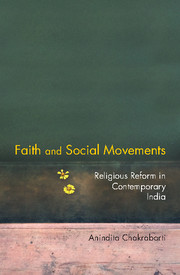Book contents
- Frontmatter
- Contents
- List of Figures
- Preface
- Acknowledgments
- Introduction: Dissent, Religion and Civil Society
- Part I Svadhyaya Ethics and the Spirit of Voluntarism
- 1 Theologies of Self-reform: What Transforms the Cross?
- 2 Praxis of an Emergent Congregation: Metaphysics of Reform and Rebirth
- 3 The Structure of Lokasaṃgraha: Volunteers, Networks and Training
- 4 Succession, Routinization of Charisma and Judicial Religion
- Part II The Tablighi Jamaat's Call for Self-reform
- Conclusion: Religion, Movements and Secularity
- Glossary
- Bibliography
- Index
2 - Praxis of an Emergent Congregation: Metaphysics of Reform and Rebirth
from Part I - Svadhyaya Ethics and the Spirit of Voluntarism
Published online by Cambridge University Press: 28 February 2018
- Frontmatter
- Contents
- List of Figures
- Preface
- Acknowledgments
- Introduction: Dissent, Religion and Civil Society
- Part I Svadhyaya Ethics and the Spirit of Voluntarism
- 1 Theologies of Self-reform: What Transforms the Cross?
- 2 Praxis of an Emergent Congregation: Metaphysics of Reform and Rebirth
- 3 The Structure of Lokasaṃgraha: Volunteers, Networks and Training
- 4 Succession, Routinization of Charisma and Judicial Religion
- Part II The Tablighi Jamaat's Call for Self-reform
- Conclusion: Religion, Movements and Secularity
- Glossary
- Bibliography
- Index
Summary
‘You are studying Svadhyaya but are you a Svadhyayi?’ On several occasions I have encountered this question during my fieldwork. One understands Svadhyaya by practising it. It is an ineffable experience where the proverbial taste of the pudding lies in the eating. Therefore, to experience and practice Svadhyaya and yet to describe oneself as a non-Svadhyayi was an oxymoron. They often pointed out that even in the Gita, it is said that the knowledge described is not to be talked about and discussed theoretically but that it must become an inward experience. This chapter discusses how a Svadhyayi acquires a new collective identity outside caste and kinship. I will discuss the nature of the new sociation that Svadhyaya fosters and the rituals that uphold it. I trace the Weberian notion of charisma as a relational concept and argue that the notion of charisma needs to be understood as a dialectical concept where the disciple follows an exemplar but at the same time, becomes a Svadhyayi only by being an exemplar to others. The attempt will be to draw attention to the metaphysical aspects of movements that address the question of agency in social movements.
While the ethical, theological teachings are addressed to one and all, it is only a few who undergo a ‘conversion’ and acquire a new identity. The Svadhyayis approach and address their co-religionists and appeal for a conversion of heart. But how does one become a member of this new community and be ‘reborn’ into it? While there is no formal dīkṣā ceremony in Svadhyaya, there are certain practices that one needs to follow to become a Svadhyayi. I will describe the practices through which an individual becomes a Svadhyayi: from an itinerant state of doing bhaktipherī, reinterpreting and participating in the rituals of an emergent congregation to the sharing of charisma in the sangha.
- Type
- Chapter
- Information
- Faith and Social MovementsReligious Reform in Contemporary India, pp. 59 - 87Publisher: Cambridge University PressPrint publication year: 2017



